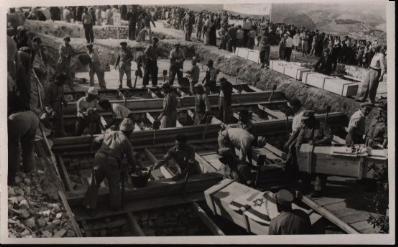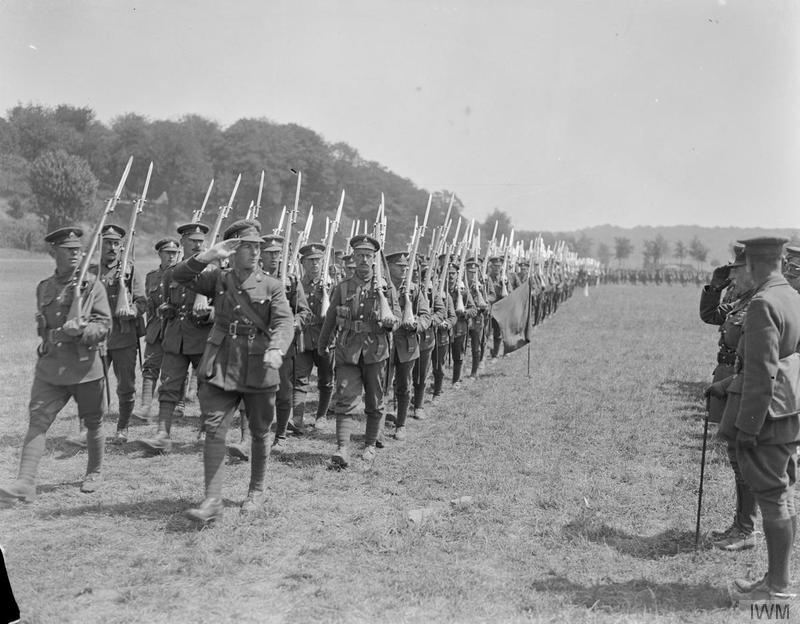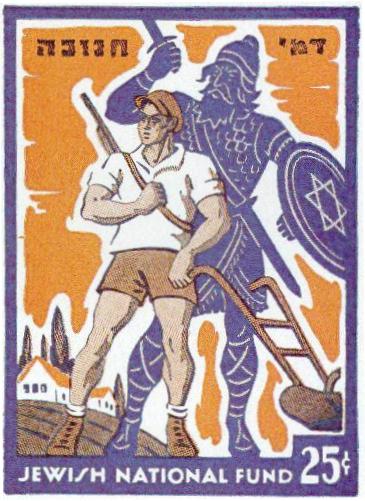|
Convoy Of 35
The Convoy of 35 (or the Lamed He, which stands for "thirty five" in Hebrew numerals), was a convoy of Haganah fighters sent during the 1947–48 Civil War in Mandatory Palestine on a mission to reach by foot and resupply the blockaded kibbutzim of Gush Etzion in January 1948, after earlier motorized convoys had been attacked. They were spotted before they could reach their target and killed in a prolonged battle by Arab irregulars and local villagers. History On 16 January 1948, a convoy of 38 men was sent by the Haganah to deliver supplies to the four blockaded kibbutzim of Gush Etzion, south of Jerusalem, following an Arab attack on January 14. The unit, named in Hebrew "Machleket HaHar" (lit. Mountain Platoon), set out on foot from Hartuv at 11 p.m. on January 15, commanded by Dani Mass. They took a detour around the Tegart fort-type Palestine Police station, to avoid detection by the British.Arieh O'Sullivan, A Magnificent Disaster, ''Jerusalem Post'', Jan 16, 1998 Three ... [...More Info...] [...Related Items...] OR: [Wikipedia] [Google] [Baidu] |
Surif
Surif ( ar, صوريف) is a Palestinian City in the Hebron Governorate located 25 km northwest of the city of Hebron. According to the Palestinian Central Bureau of Statistics census, Surif had a population of 17,650 in 2016. The population is entirely Muslim. Most of the town's 15,000 dunams is used for agriculture, in particular, olives, wheat and barley. There are seven mosques and four schools located in its vicinity. Ahmad Lafi is the mayor. History In 1838 Surif was noted as a Muslim village, located between Hebron and Gaza, but subjected to the government of Hebron. In 1863 Victor Guérin found Surif to be a village with 700 inhabitants. He further noted that beside a ''birket'' in the rock, a few cisterns and an ancient column shaft which was placed near a small mosque, all of Surif's constructions seemed more or less modern. An official Ottoman village list from about 1870 showed 87 houses and a population of 265, counting men only. In 1883, the PEF's '' ... [...More Info...] [...Related Items...] OR: [Wikipedia] [Google] [Baidu] |
1948 Arab-Israeli War
Events January * January 1 ** The General Agreement on Tariffs and Trade (GATT) is inaugurated. ** The Constitution of New Jersey (later subject to amendment) goes into effect. ** The railways of Britain are nationalized, to form British Railways. * January 4 – Burma gains its independence from the United Kingdom, becoming an independent republic, named the ''Union of Burma'', with Sao Shwe Thaik as its first President, and U Nu its first Prime Minister. * January 5 ** Warner Brothers shows the first color newsreel (''Tournament of Roses Parade'' and the ''Rose Bowl Game''). ** The first Kinsey Reports, Kinsey Report, ''Sexual Behavior in the Human Male'', is published in the United States. * January 7 – Mantell UFO incident: Kentucky Air National Guard pilot Thomas Mantell crashes while in pursuit of an unidentified flying object. * January 12 – Mahatma Gandhi begins his fast-unto-death in Delhi, to stop communal violence during the Partition of India. * ... [...More Info...] [...Related Items...] OR: [Wikipedia] [Google] [Baidu] |
The New York Times
''The New York Times'' (''the Times'', ''NYT'', or the Gray Lady) is a daily newspaper based in New York City with a worldwide readership reported in 2020 to comprise a declining 840,000 paid print subscribers, and a growing 6 million paid digital subscribers. It also is a producer of popular podcasts such as '' The Daily''. Founded in 1851 by Henry Jarvis Raymond and George Jones, it was initially published by Raymond, Jones & Company. The ''Times'' has won 132 Pulitzer Prizes, the most of any newspaper, and has long been regarded as a national " newspaper of record". For print it is ranked 18th in the world by circulation and 3rd in the U.S. The paper is owned by the New York Times Company, which is publicly traded. It has been governed by the Sulzberger family since 1896, through a dual-class share structure after its shares became publicly traded. A. G. Sulzberger, the paper's publisher and the company's chairman, is the fifth generation of the family to head the pa ... [...More Info...] [...Related Items...] OR: [Wikipedia] [Google] [Baidu] |
Sa'sa'
Sa'sa' ( ar, سعسع, he, סעסע) was a Palestinian village, located 12 kilometres northwest of Safed that was depopulated by Israeli forces during the 1948 Arab-Israeli war. The village suffered two massacres committed by Haganah forces: one in mid-February 1948 and the other at the end of October the same year.Khalidi, 1992, p. 495 Its place has been taken since 1949 by Sasa, an Israeli kibbutz. History Sa'sa' was built on the site of a Bronze Age (early second millennium B.C.) settlement whose remains (walls, tombs, cisterns, and olive and wine presses), have been unearthed. One village house had foundations which has been dated back to fourth century by archaeologists. Another excavated in 2003 yielded ceramics dated to the fourteenth–fifteenth centuries CE. The Arab geographer Abū 'Ubayd 'Abd Allāh al-Bakrī (d.1094) reported that one passed through Sa'sa' when travelling from Dayr al-Qasi to Safad. Ottoman era In 1516 Sa'sa', with the rest of Palestine, came under ... [...More Info...] [...Related Items...] OR: [Wikipedia] [Google] [Baidu] |
Palmach
The Palmach (Hebrew: , acronym for , ''Plugot Maḥatz'', "Strike Companies") was the elite fighting force of the Haganah, the underground army of the Yishuv (Jewish community) during the period of the British Mandate for Palestine. The Palmach was established on 15 May 1941. By the outbreak of the 1948 Arab–Israeli War it consisted of over 2,000 men and women in three fighting brigades and auxiliary aerial, naval and intelligence units. With the creation of Israel's army, the three Palmach Brigades were disbanded. This and political reasons compelled many of the senior Palmach officers to resign in 1950. The Palmach contributed significantly to Israeli culture and ethos, well beyond its military contribution. Its members formed the backbone of the Israel Defense Forces high command for many years, and were prominent in Israeli politics, literature and culture. History The Palmach was established by the Haganah High Command on 14 May 1941. Its aim was to defend the Palestin ... [...More Info...] [...Related Items...] OR: [Wikipedia] [Google] [Baidu] |
Mukhtar
A mukhtar ( ar, مختار, mukhtār, chosen one; el, μουχτάρης) is a village chief in the Levant: "an old institution that goes back to the time of the Ottoman rule". According to Amir S. Cheshin, Bill Hutman and Avi Melamed, the mukhtar "for centuries were the central figures". They "were not restricted to Muslim communities" where even non-Arab "Christian and Jewish communities in the Arab world also had mukhtars." Quoting Tore Björgo: "The mukhtar was, among other things, responsible for collecting taxes and ensuring that law and order was prevailing in his village". See also * Kodjabashi The kodjabashis ( el, κοτζαμπάσηδες, kotzabasides; singular κοτζάμπασης, ''kotzabasis''; sh, kodžobaša, kodžabaša; from tr, kocabaṣı, hocabaṣı) were local Christian notables in parts of the Ottoman Balkans, most ... References External links * Arabic words and phrases Ottoman Empire {{Ottoman-stub ... [...More Info...] [...Related Items...] OR: [Wikipedia] [Google] [Baidu] |
Royal Sussex Regiment
The Royal Sussex Regiment was a line infantry regiment of the British Army that was in existence from 1881 to 1966. The regiment was formed in 1881 as part of the Childers Reforms by the amalgamation of the 35th (Royal Sussex) Regiment of Foot and the 107th Regiment of Foot (Bengal Light Infantry). The regiment saw service in the Second Boer War, and both World War I and World War II. On 31 December 1966, the Royal Sussex Regiment was amalgamated with the other regiments of the Home Counties Brigade – the Queen's Royal Surrey Regiment, the Queen's Own Buffs, The Royal Kent Regiment, and the Middlesex Regiment (Duke of Cambridge's Own) – to form the Queen's Regiment; which was later, on 9 September 1992, amalgamated with the Royal Hampshire Regiment to form the present Princess of Wales's Royal Regiment (Queen's and Royal Hampshires). History 1881–1914 The regiment was formed in 1881 as part of the Childers Reforms by the amalgamation of the 35th (Royal Sussex) Regi ... [...More Info...] [...Related Items...] OR: [Wikipedia] [Google] [Baidu] |
Hebron
Hebron ( ar, الخليل or ; he, חֶבְרוֹן ) is a Palestinian. city in the southern West Bank, south of Jerusalem. Nestled in the Judaean Mountains, it lies above sea level. The second-largest city in the West Bank (after East Jerusalem), and the third-largest in the Palestinian territories (after East Jerusalem and Gaza), it has a population of over 215,000 Palestinians (2016), and seven hundred Jewish settlers concentrated on the outskirts of its Old City. It includes the Cave of the Patriarchs, which Jewish, Christian, and Islamic traditions all designate as the burial site of three key patriarchal/ matriarchal couples. The city is often considered one of the four holy cities in Judaism. as well as in Islam. Hebron is considered one of the oldest cities in the Levant. According to the Bible, Abraham settled in Hebron and bought the Cave of the Patriarchs as a burial place for his wife Sarah. Biblical tradition holds that the patriarchs Abraham, Isaac, and ... [...More Info...] [...Related Items...] OR: [Wikipedia] [Google] [Baidu] |
Irgun
Irgun • Etzel , image = Irgun.svg , image_size = 200px , caption = Irgun emblem. The map shows both Mandatory Palestine and the Emirate of Transjordan, which the Irgun claimed in its entirety for a future Jewish state. The acronym "Etzel" is written above the map, and "raq kach" ("only thus") is written below. , dates = 1931–1948 , country = Yishuv, Mandatory Palestine Israel , type = Paramilitary (pre-independence) Unified armed forces (post-independence) , role = , size = , battles = Arab Revolt in PalestineWorld War II *Anglo-Iraqi War *Syria–Lebanon Campaign Jewish Revolt in Palestine Palestine Civil War1948 Arab–Israeli War , disbanded = 11 June 1948 , commander1 = , commander1_label = , commander2 = , commander2_label = , commander3 = , commander3_label = , notable_commanders = Ze'ev Jabotinsky, Avraham Tehomi, Menachem Begin , identification_symbol = , identification_symbol_label = , identification_symbol_2 = , identification_symbol_2_label ... [...More Info...] [...Related Items...] OR: [Wikipedia] [Google] [Baidu] |
Hebrew Communists
The Hebrew Communists ( he, קומוניסטים עברים, ''Komunistim Ivrim'') were a short-lived political party in Mandatory Palestine and Israel. The Hebrew Communists were founded in 1945 by some former members of the Palestine Communist Party (PCP), which had split in 1943. The party operated until after Israeli independence in 1948, at which point it merged with the National Liberation League and MAKEI to form Maki. The party was resurrected during the first Knesset when several of Maki's leaders, including Knesset member Eliezer Preminger, were purged soon after the elections in 1949. Rather than vacate his seat for another Maki member, Preminger remained in the Knesset The Knesset ( he, הַכְּנֶסֶת ; "gathering" or "assembly") is the unicameral legislature of Israel. As the supreme state body, the Knesset is sovereign and thus has complete control of the entirety of the Israeli government (with ... and reformed the Hebrew Communists on 8 June 194 ... [...More Info...] [...Related Items...] OR: [Wikipedia] [Google] [Baidu] |
Aliyah
Aliyah (, ; he, עֲלִיָּה ''ʿălīyyā'', ) is the immigration of Jews from Jewish diaspora, the diaspora to, historically, the geographical Land of Israel, which is in the modern era chiefly represented by the Israel, State of Israel. Traditionally described as "the act of going up" (towards the Jerusalem in Judaism, Jewish holy city of Jerusalem), moving to the Land of Israel or "making aliyah" is one of the most basic tenets of Zionism. The opposite action—emigration by Jews from the Land of Israel—is referred to in the Hebrew language as ''yerida'' (). The Law of Return that was passed by the Knesset, Israeli parliament in 1950 gives all diaspora Jews, as well as their children and grandchildren, the right to relocate to Israel and acquire Israeli citizenship on the basis of connecting to their Jewish identity. For much of Jewish history, their history, most Jews have lived in the diaspora outside of the Land of Israel due to Jewish military history, various hi ... [...More Info...] [...Related Items...] OR: [Wikipedia] [Google] [Baidu] |


.png)



